
Cupids Fighting Putti is a c. 1625 oil on canvas painting by Guido Reni, now in the Galleria Doria Pamphilj, in Rome. [1]

Cupids Fighting Putti is a c. 1625 oil on canvas painting by Guido Reni, now in the Galleria Doria Pamphilj, in Rome. [1]
The painting was probably influenced by his constant disputes with the papal treasurer whilst producing a painting for the Quirinal Palace - Reni was accused of being slow, arrogant and stubborn and out of disgust for the treasurer he left Rome without finishing the work or saying farewell to the pope. Whilst working on a fresco for the church of San Domenico in Bologna he was visited by a cardinal legate on behalf of the pope but refused his request to return to Rome to complete the decoration of Santa Maria Maggiore. The cardinal was appalled and attempted to imprison Reni, but he escaped and went into hiding, planning to leave Italy for the royal court in France or Spain. Reni's friend and protector Marquis Facchinetti convinced the cardinal-legate of Bologna to annul the sentence and persuaded Reni to return to Rome and accept the commission entrusted to him by the pope. In gratitude for his assistance, the artist painted Cupids Fighting Putti and gave the work to the Marquis. [2] One of several copies of it is now in the National Museum, Kraków. [3]
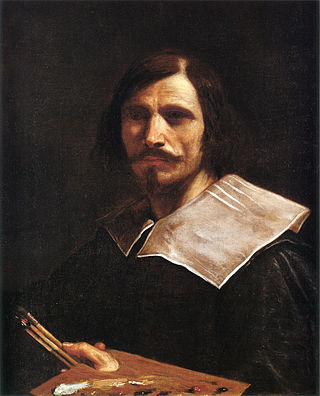
Giovanni Francesco Barbieri, better known as (il) Guercino, was an Italian Baroque painter and draftsman from Cento in the Emilia region, who was active in Rome and Bologna. The vigorous naturalism of his early manner contrasts with the classical equilibrium of his later works. His many drawings are noted for their luminosity and lively style.

Annibale Carracci was an Italian painter and instructor, active in Bologna and later in Rome. Along with his brother and cousin, Annibale was one of the progenitors, if not founders of a leading strand of the Baroque style, borrowing from styles from both north and south of their native city, and aspiring for a return to classical monumentality, but adding a more vital dynamism. Painters working under Annibale at the gallery of the Palazzo Farnese would be highly influential in Roman painting for decades.

Guido Reni was an Italian painter of the Baroque period, although his works showed a classical manner, similar to Simon Vouet, Nicolas Poussin, and Philippe de Champaigne. He painted primarily religious works, but also mythological and allegorical subjects. Active in Rome, Naples, and his native Bologna, he became the dominant figure in the Bolognese School that emerged under the influence of the Carracci.
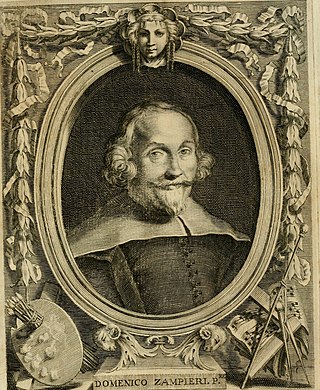
Domenico Zampieri, known by the diminutive Domenichino after his shortness, was an Italian Baroque painter of the Bolognese School of painters.
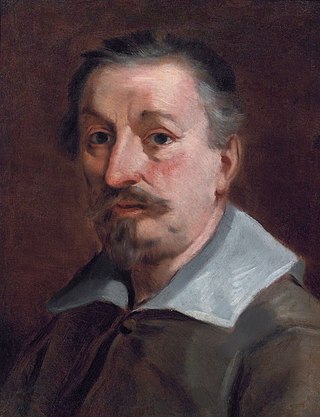
Francesco Albani or Albano was an Italian Baroque painter of Albanian origin who was active in Bologna, Rome, Viterbo (1609–1610), Mantua (1621–1622) and Florence (1633).

Stanislaus Hosius was a Polish Roman Catholic cardinal. From 1551 he was the Prince-Bishop of the Bishopric of Warmia in Royal Prussia, and from 1558, he served as the papal legate to the Holy Roman Emperor's Imperial Court in Vienna, Austria. From 1566 he was also the papal legate to Poland.

Francesco Alidosi was an Italian cardinal, diplomat and condottiero, remembered as a friend and favourite of Pope Julius II, used by Michelangelo to smooth his relations with his difficult patron. He accompanied Giuliano della Rovere to France in 1494, and continued in favour when Della Rovere was elected pope, becoming Pope Julius II. Alidosi was elected as bishop of Mileto in 1504, and then transferred to the see of Pavia on 26 March 1505. He occupied the seat until his murder in 1511.
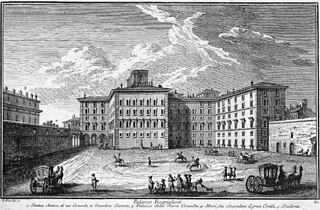
The Palazzo Pallavicini-Rospigliosi is a palace in Rome, Italy. It was built by the Borghese family on the Quirinal Hill; its footprint occupies the site where the ruins of the baths of Constantine stood, whose remains still are part of the basement of the main building, the Casino dell'Aurora. Its first inhabitant was the famed art collector Cardinal Scipione Borghese, the nephew of Pope Paul V, who wanted to be housed near the large papal Palazzo Quirinale. The palace and garden of the Pallavicini-Rospigliosi were the product of the accumulated sites and were designed by Giovanni Vasanzio and Carlo Maderno in 1611–16. Scipione owned this site for less than a decade, 1610–16, and commissioned the construction and decoration of the casino and pergolata, facing the garden of Montecavallo. The Roman palace of this name should not be mistaken for the panoramic Villa Pallavicino on the shores of Lake Como in Lombardy. The Palace has also been the scene of important cultural and religious events. On June 6, 1977 Princess Elvina Pallavicini invited in Palazzo Pallavicini Rospigliosi the archbishop monsignor Marcel Lefebvre for a conference on the Second Vatican Council and for the celebration of a Traditiona Mass, under the careful direction of the marquis Roberto Malvezzi, and Frigate Captain marquis Luigi Coda Nunziante di San Ferdinando. Many members of Alleanza Cattolica, the baron Roberto de Mattei, the pharmacologist Giulio Soldani, the sociologist Massimo Introvigne, the psychiatrist Mario Di Fiorino and Attilio Tamburrini and his brother Renato Tamburrini took part to the event.

The Judgement of Paris refers to any of the several paintings of the Judgement of Paris produced by Peter Paul Rubens, though he did not match the 22 depictions of the subject attributed to Lucas Cranach the Elder. There were versions before about 1606, then he returned to the subject thirty years later; all take the opportunity to show nude females from different angles.
Luigi Capponi was an Italian Catholic cardinal who became archbishop of Ravenna.

Francesco Gonzaga was an Italian bishop and a Cardinal of the Roman Catholic Church during the reigns of Popes Pius II, Paul II and Sixtus IV.

Amico Agnifili was an Italian Roman Catholic bishop and cardinal.
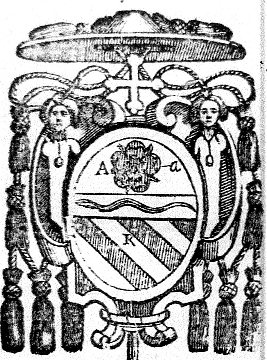
Giambattista Orsini was an Italian Roman Catholic cardinal. He served as papal legate to the Marches of Ancona.

Berlinghiero Gessi was an Italian Catholic Cardinal.
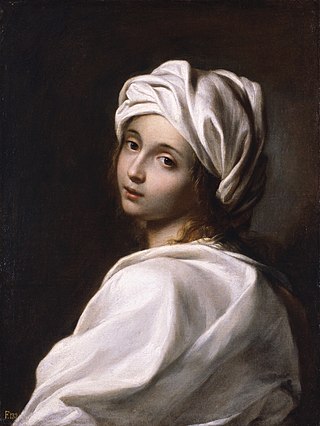
The Portrait of Beatrice Cenci is a painting once attributed to the Italian Baroque painter Guido Reni but now to Ginevra Cantofoli. It is housed in the Galleria Nazionale d'Arte Antica of Palazzo Barberini, Rome. The painting dealt with a controversial topic of Beatrice Cenci, a woman who was executed by Papal authorities, specifically Pope Clement VIII Aldobrandini.

Saint Sebastian Thrown into the Cloaca Maxima is a 1612 oil on canvas painting by Ludovico Carracci, now in the Getty Museum in Los Angeles, which acquired it in 1971. A preparatory drawing survives in the Louvre.

Venus with a Satyr and Two Cupids or The Bacchante is a 1588-1590 oil on canvas painting by Annibale Carracci, now in the Uffizi in Florence. Its dating is based on its strong Venetian influence - the artist was briefly in the city at the end of the 1580s.

The Death of Dido is a 1631 oil-on-canvas painting by the Italian Baroque painter Guercino, commissioned by Cardinal Bernardino Spada for Maria de' Medici. It now hangs in the Galleria Spada in Rome.

The Abduction of Helen is a 1628-1629 oil on canvas painting by Guido Reni, now in the Louvre Museum in Paris.